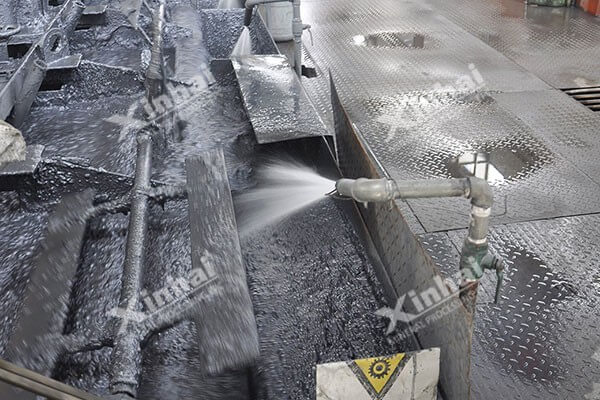

Warm Tip: If you want to know more details about equipment, solutions, etc, please click the button below for free consultation, or leave your requirements!
The froth flotation process is a mineral processing technology with a wide application range and strong adaptability. It can be applied to almost all kinds of minerals such as non-ferrous metals, rare metals and non-metals. And it can process more than 100 minerals, especially for gold extraction. At the same time, the froth flotation process is also a relatively complex mineral processing process, and there are many factors affecting the flotation effect, such as the particle size of ore, ore properties, pulp pH and so on.
This article will introduce three factors and solutions that affect froth flotation process.

Froth flotation process mainly includes grinding, pulp conditioning and dosing, froth flotation separation and dewatering of foam products and tailings products after flotation.
Before the froth flotation operation started, the ore needs to be ground to optional particle size range. Generally it is ground to less than 0.1 mm. When the froth flotation is too coarse, the the particles size of ore (greater than 0.1 mm) will increase the exfoliation force of the ore due to the larger weight. Very fine particles (usually means the particle size of ore less than 5-10 μm), due to the small weight of the mineral particles, is easy to adhere to the surface of the coarse particles, then reducing the floatability of the coarse particles. So if the particles size of ore are too coarse or too fine, the recovery rate of ore would reduce.
When processing coarse ore particles in froth flotation, we should
1) Use a collector with strong collecting power, you can also add auxiliary collectors such as kerosene and diesel to strengthen the collection of coarse particles and increase the adhesion of the ore particles to the bubbles, thus reduce the falling of mineral particles.
2) Appropriately increase the mass fraction of the pulp and increase the buoyancy of the pulp.
Under the premise of ensuring the stability of the foam layer, the mixture should be appropriately stirred to promote the suspension of the coarse particles and the chance of adhesion to the bubbles.
When processing fine ore particles in froth flotation, we should
1) Use selective flocculation flotation, the flocculant is used to selectively flocculate the target mineral particles or gangue fine mud, and then separate them by flotation.
2) Use carrier flotation, using the ore particles of general flotation size as a carrier, so that the fine particle of target mineral cover is floating on the carrier.
The carrier may be of the same type or a heterogeneous mineral. For example, pyrite may be used as a carrier for flotation of fine gold. The calcite may be used as a carrier to float the fine iron and titanium impurities in the kaolin.
In the process of pulp conditioning and dosing, it is necessary to control the pulp pH value.
The pH of the pulp has a great influence on the flotation index. It should be measured with the test paper at intervals to ensure that the pH value is maintained at a stable value. The mineral can only be fully floated or suppressed at a suitable pH value. The pH value is controlled by adjusting reagents such as lime, sodium sulfate and sulfuric acid. There are usually two methods for controlling the pH:
1) Use fixed-value adjustment to keep the pH constant. This is a method that is commonly used in some domestic factories.
2) Track the changes of ore properties and adjust the pH value in time to obtain better flotation indicators. For example, adjust the pH in the process of copper-nickel mixed flotation to achieve the maximum possible recovery.
In the process of pulp conditioning and dosing, it is necessary to control the pulp within proper concentration.
The pulp concentration will affect the froth flotation effect to a certain extent.
When the adjusted slurry is sent to the flotation cell, the mineral particles with strong hydrophobic surface adhere to the surface of the bubble and are carried by the bubble to float up to the surface of the slurry, form a foam layer, and then being scraped out to be a concentrate what is usually our need. And the particles which stay in the slurry and are excluded from the tank along with the slurry flow is to be tailings. So the concentration of the pulp and the liquid level need to be stable to ensure the amount of scraping and the foam should be scraped off the board completely.
The slurry concentration should be 25% to 35% when we process coarse particles. And during the froth flotation process of fine particles and the ore containing high mud, the slurry concentration should be 10% to 20%. Because the larger the particle size is, the thicker the slurry concentration should be. When the flotation density is small, the fine and muddy minerals should use a relatively thin pulp. But in practice, the concentration of the slurry needs to be determined according to the property of the flotation ore and related technical requirements.
So, in order to achieve the best results in the froth flotation separation operation, the staff in the mineral processing plant also needs to have a holistic understanding of the entire process. Both initial grinding operation and the control of the overall process stability during the froth flotation separation process are essential.
12 Types of Froth Flotation Processes
 2
2
 4317
4317
2How to Choose the Froth Flotation Process According to the Flotation Stage?
 0
0
 3835
3835
37 Factors That Influences the Froth Flotation Effect
 0
0
 5717
5717


What Are the Differences Between CIP and CIL?
 11577
11577
 0
0